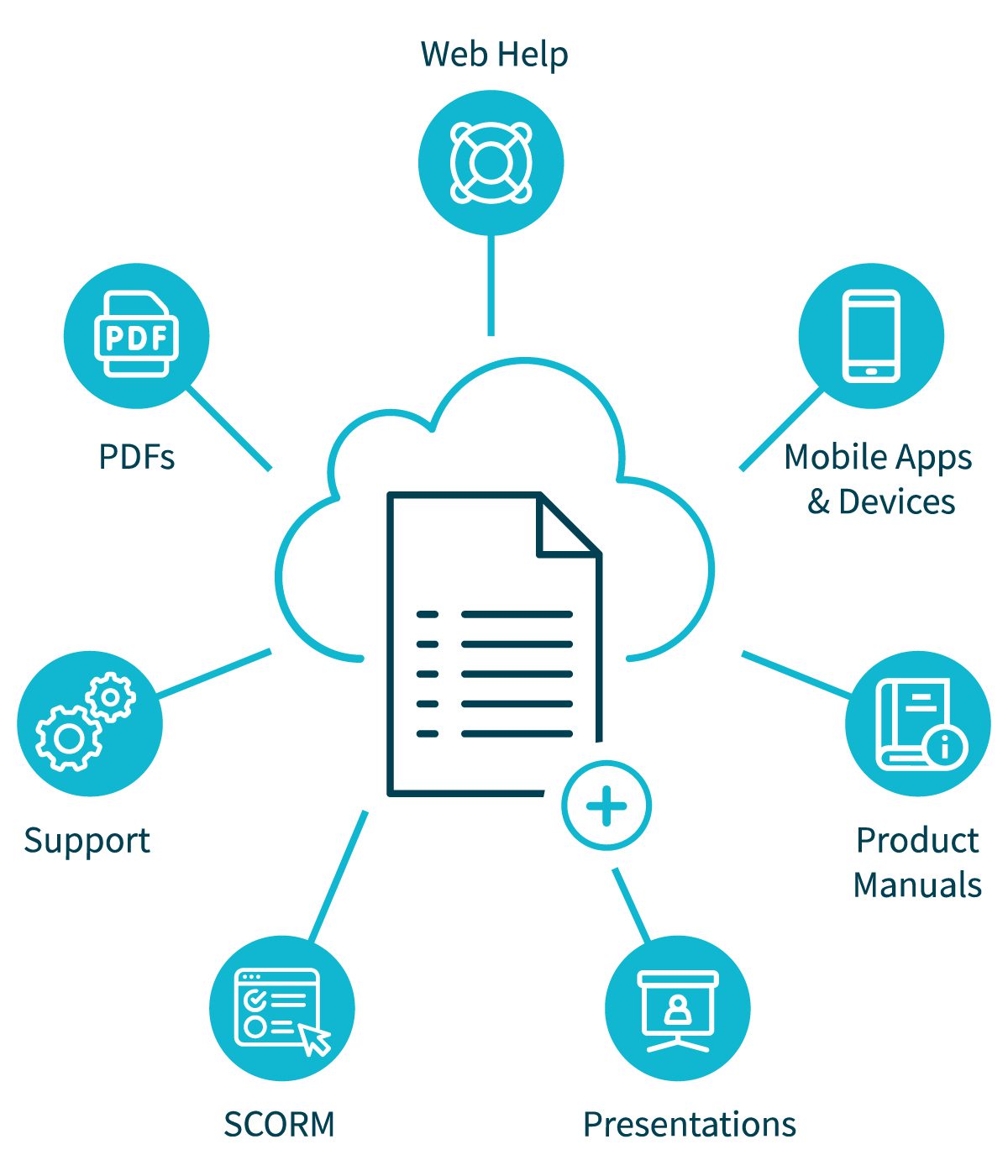Single sourcing vs multi-sourcing: which system is right for your technical documentation?
Introducing a new component content management system (CCMS) into your business, whether it focuses on single sourcing or multi-sourcing, can be expensive and risky. You have to migrate old data, reorganize workflow, retrain employees and hope that they embrace it.
Reducing these stressors starts with asking one all-important question: Who should control your content architecture: individuals in upper management, or line managers within specific divisions?
The truth is that choosing either option has drawbacks, and in a single sourcing system, you would have to choose one or the other. Multi-sourcing is an attempt at a compromise.
Table of contents
What is single sourcing?
In a single sourcing model, an organization uses a single source file to produce multiple pieces of content, such as manuals, media and FAQs. This document is converted to multiple different formats, increasing its utility across the organization.
Imagine working for an international organization where, to simplify the flow of information for upper management, everyone has to speak the same language. But this language is foreign to everybody who works there. It’s difficult for the employees to create freely and produce their best work under this constraint, breeding a lot of resentment among the staff.


What are the benefits of single sourcing?
The single sourcing model can streamline inefficiencies in workflow by removing duplicated, superfluous and off-brand sources of information. It allows our international organization to clarify and pursue organization-wide goals by centralizing the control of all content.
For example: an organization-wide goal might be a “unified user experience”, where documentation from different departments, in all media and languages, looks and feels the same to every customer. This can only be achieved if upper management has full control over the creative direction of the content.
Single sourcing disadvantages
Unfortunately, with single sourcing, that’s asking a lot of the employees manipulating the source material. They need to be versatile enough to support every potential output and all of the operations you want to perform on it.
For content writers, creating and drawing from a single source file requires a multitude of tasks beyond writing. To keep the file malleable between all potential outputs, they have to build style sheets for each possible use, define reusable chunks of content, prioritize various features and assign controls to them.
This leads to all sorts of negative side effects within an organization, not least of which is user resistance. Low morale, frustration and higher churn might pressure employees to continue using “shadow” or “rogue” systems not authorized by the company.
Two trends in the industry have only made this problem worse: Technical Publication departments have shrunk in recent years, while companies have begun to produce more and more content for general consumption; on blogs, knowledge bases, social media and forums.
Content creators bear the brunt of the system’s complexity in a single sourcing structure, trading in their creative independence for a whole clutter of adjacent tasks, which often require expensive, specialized training.
What is multi-sourcing?
In a multi-sourcing model, content produced using a variety of systems is collected and run through a shared CCMS, which converts the content to whichever output is needed. In this way, creators and subject matter experts (SMEs) are free to continue using the systems that best suit their needs and training.
Let’s return to our example of the international organization. In a multi-sourcing set-up, each employee would get to use their own native language, with one neutral language being used for interdepartmental communication only. Like using French at home and Latin in Church.


What are the benefits of multi-sourcing?
A multi-sourcing system takes into account one simple fact: companies are living systems, built and run by unique individuals. Different departments develop their own cultures, which allow them to survive and prosper.
Workers within a department maintain control over what content is created and how, within some limits imposed from higher management. These limits ensure that content from different departments can be mixed and matched. The end result is that individual contributors aren’t wasting time drawing roadmaps for other creators instead of producing high quality content, and they can maintain authority over their own data.
Now, you might be looking at the compartmentalized structure of the multi-sourcing model and thinking it looks an awful lot like “silos”. The dreaded cubicle wall that rises up between departments and suppresses communication. You wouldn’t be wrong, but while “silos” remain a much-maligned term in the industry, the argument for tearing them down just doesn’t hold water anymore.
The long, troubled history of “tearing down the silos”
In the late 1980s, IT companies were beginning to see a new demand emerging in the market. Big businesses wanted to invest in single systems that could support multiple departments, instead of the hodge-podge of platforms that only functioned well in particular divisions.
The lack of internal communication was costing businesses money and time, and by the early ’90s, a new ethos had emerged: tear down the “silos” and re-engineer your business to function seamlessly over different divisions.
It was a hit. The passion for this subversive new model peaked in the mid-’90s, with companies including Eastman Kodak Co., Ford Motor Co. and Taco Bell reporting great results.
But successful transitions weren’t the norm. The process had a high price tag for retraining and reorganizing employees, and resistance to such big cultural shifts saw the fad fall out of favor after only a few years. Both Apple Computers and Pacific Bell attributed major layoffs to the new structure in 1993, while a series of studies showed that at least 70% of these restructuring initiatives actually made things worse.
By 1995, many of its leading pioneers were disavowing the process. Thomas Davenport, an early champion, apologized for its many failures in an article for Fast Company. In 2013, Inc.com ranked it #3 on their list of World’s Worst Management Fads.
So, what does “siloed” multi-sourcing mean for CCMS today?
Let’s return to our fundamental question: Whose job is it to decide on your content architecture and manage the complexity of your CCMS?
In the ’80s and early ’90s, individual content creators may have been the only viable answer. Laboring over a single, transmutable source file was the best way of getting everyone on the same page reliably.
But this extra work just isn’t necessary with a modern, intelligent CCMS. A middle-man system can grapple with multiple sources, knocking hours off of a content creator’s workload by handling superfluous tasks and streamlining content without watering down the original source material.
A multi-sourcing system has the added benefit of integrating more easily with your pre-existing company culture. Each content creator, whether they be in finance, marketing or HR, has their own voice and workflow, and the software you choose shouldn’t stifle their creativity by enforcing clumsy, top-down standards. Celebrate diversity; don’t smother it!
To learn more about how multi-sourcing CCMS can deliver better, on-brand results, contact Author-It’s team of experts or request a demo.





